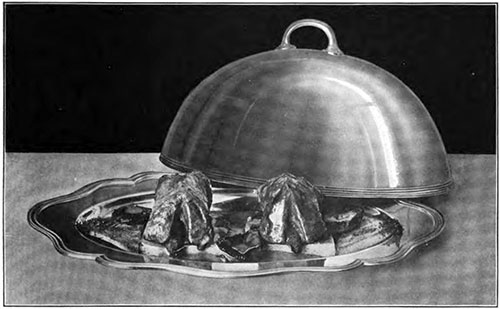Stewing - Vintage Cooking Process

Stewed Pigeons on Toast © 1913 American Cookery
Stewing is merely another form of simmering, with the exception that when it is employed, but a small quantity of liquid is used. Meats cooked by this method yield all of their juices and gelatins, and the gravy is rich and nourishing.
Stewing is generally defined as a gradual process of simmering in a small quantity of liquor.
Stewing implies long cooking at simmering point in a small quantity of water or liquid. The aim is to soften the fibers and make a rich gravy by extracting material from the food.
Stewing is cooking in a small amount of hot water for a long time at low temperature; it is the most economical way of cooking meats, as all nutriment is retained, and the ordinary way of cooking cheaper cuts. Thus fibre and connective tissues are softened, and the whole is made tender and palatable.
From the point of economy, this form of cooking should be best understood because it is the least expensive and most nourishing way of cooking. The advantage which stewing can claim over boiling or simmering is that the more nourishing and soluble elements are not separated from, but served up with the meat, the full flavor of which is thereby better preserved.
Stewing is one of the most economical methods of cooking meat, because the coarser and cheaper parts of meat, which cannot well be used for roasting or boiling, can be slow continuous stewing, be made tender, palatable and nutritious.
The meat selected for stewing should be lean, or but with little fat. Stewing entails less loss; all the juices coming out of the meat, amalgamate with the gravy or sauce which is served with the meat. Very little fuel and attention are needed to cook a stew after it has started cooking.
The heat must be slow and gradual -- never reaching the actual boiling point -- and the soup must be removed occasionally. Some meats and fruits and certain vegetables are usually subjected to stewing. Only enough liquid is used to cover the meat to prevent evaporation. Tough meat unsuitable either for roasting or boiling, can be made tender and palatable by stewing.
There is practically no waste in nutriment, for solids and liquids are both served up. Little fuel and little attention are required. There are two ways of stewing known and practiced: The first is partly frying or browning the meat before stewing and the second is parboiling.
Rules for Stewing
Stewing is cooking at simmering point in a small quantity of liquid. It is an economical method of cooking, because what is lost from the meat is in the gravy, which is always served with it.
Meat to be stewed should be put into a stewpan with enough hot water to cover it, and kept at simmering point until tender, but no longer. The meat in stews is often as ragged and flavorless as meat from which stock has been made, simply from over stewing.
There can be no reasonable excuse made for such a fault, as the stew may be removed from the fire when ready, and reheated when required -without at all deteriorating. It is not like roast or boiled meat which must be served as soon as cooked to be in perfection.
The length of time allowed for stewing will entirely depend on the kind of meat stewed; very tough meat will sometimes take four hours or more before it becomes tender; pieces of meat like ox-cheek or shin of beef always require long cooking.
If tough meat is dipped in vinegar before it is stowed the action of the acid on the fiber will cause it to soften more readily. Vegetables are generally stewed with the meat as they improve both the flavor of the meat and the gravy.
The secret of success in stewing lies in slow cooking, therefore care should be taken that the gravy is never allowed to boil. A gentle bubble now and again at one side of the saucepan is the indication of simmering heat.
A double saucepan is exceedingly useful for stewing, or the stewpan containing the meat may be put to stand in a larger one containing boiling water; cooked thus there is no possibility of the stew itself boiling.
When stewing meats, the searing of the surface may be accomplished either by plunging the meat into boiling water, or by browning it on all sides in a very little drippings. For a rich brown stew, the latter method is advisable, but as it is more troublesome, the first is frequently used.
Table Talk: The American Authority upon Culinary Topics and Fashions of the Table, Vol. XXVII, 1912, A Series of Articles Published Throughout the Year. Published Monthly by The Arthur H. Crist Co., Cooperstown, NY. A Monthly Magazine Devoted to the Interests of American Housewives, Having special reference to the Improvement of the Table. Marion Harris Neil, Editor.
Fannie Merritt Farmer, The Boston Cooking-school Cook Book, Revised Edition, Boston: Little, Brown, and Company (1912), p. 19
